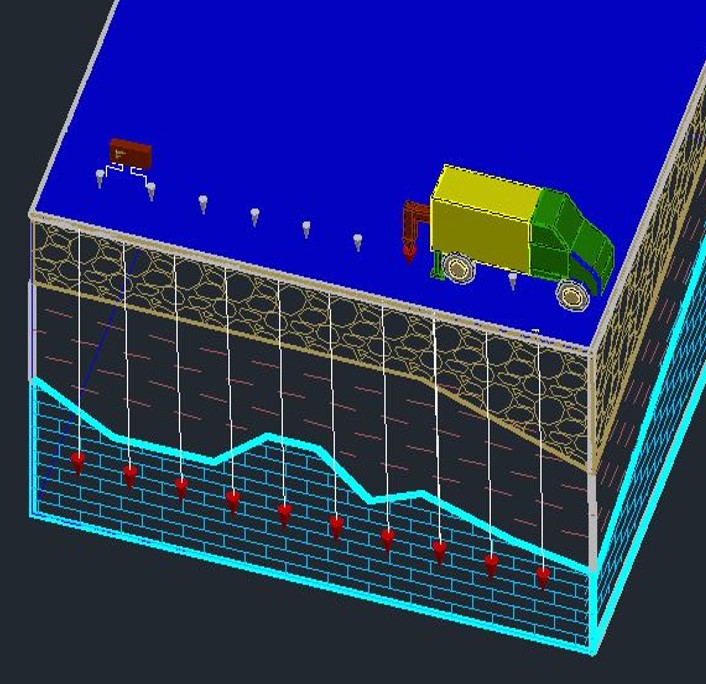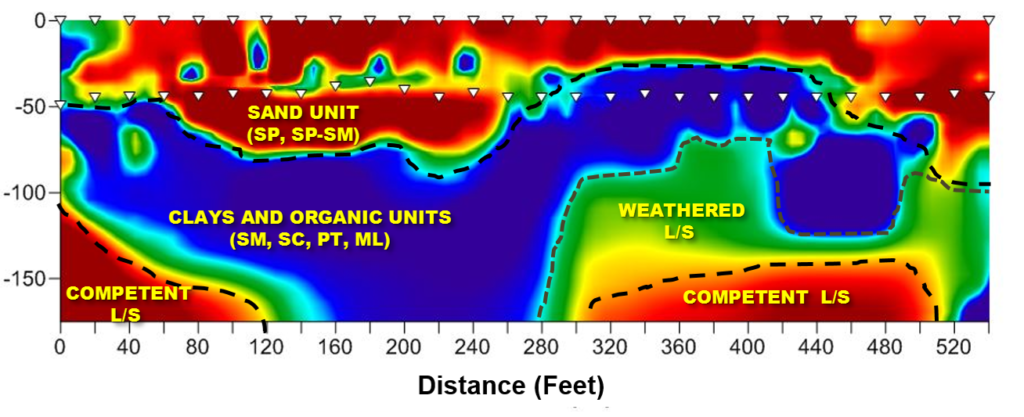
MERIT implants are installed permanently using Direct Push (DP). DP provides a fast and economical technique to install full length geophysical arrays in the subsurface. The installed series of implants act as transmitters and receivers providing deeper energy and detection sources. When combined with surface electrodes MERIT’s tomographic imaging capability is substantially superior to geophysical methods that only use energy delivered from the surface.
- Implants are introduced into the subsurface in an array intersecting the area of interest.
- The implants are positioned in the subsurface at the elevation so that the electrical fields cover the area of interest.
- Surface electrodes are placed directly above the implanted array.
- Surface and implanted electrodes are connected to standard electrical resistivity geophysical instruments.
- An optimization program is used to collect the geophysical data from the surface electrodes, the lower implanted electrodes, and between the upper and lower electrodes.
- Thousands of data points are collected over a period of hours.
- Data is processed (inverted) using a our technique.
Example of MERIT’s high resolution subsurface imaging.

Multi-Electrode Resistivity Implant Technique (MERIT) is patent-pending technology for imaging and monitoring the subsurface. MERIT works very similar to Computerized Tomography (CT) medical scanning technology, using a proven geophysical method called electrical resistivity tomography (ERT), but in a unique way. Electrical resistivity methods have successfully been used in investigation of dams, sinkholes, contaminated sites, water resources, and saltwater intrusions studies. The electrical resistivity geophysical method can identify leaks and seepage pathways in dams, measure bedrock, identify landslide slip geometry, and locate voids in the subsurface.
MERIT technology uses implants placed into the lower part of the subsurface to inject more current into subsurface than surface ER methods, which gets more and better energy nearer the areas of interest. When combined, the implants and surface electrodes construct a tomographic configuration. This unique tomographic arrangement creates a high density of data collection between the surface and implanted electrodes. The current can be injected also below the implanted electrodes in the subsurface increasing the depth of penetration of the MERIT method.
The results of MERIT have been confirmed by exploration drilling using both Standard Penetration Testing (SPT) and Cone Penetration Testing (CPT) by the Florida Department of Transportation, Florida Department of Environmental Protection, Orlando utilities Water Conserv II, and private geotechnical firms.
MERIT has the ability in most cases to provide an image from the surface and into the bedrock. This provides an image of complete unconsolidated subsurface and bedrock sediment interface. For geotechnical engineering applications the interface may be critical for foundation studies. Due to the implant method MERIT will be able to image the core and foundations of high and geologically complex structures.
